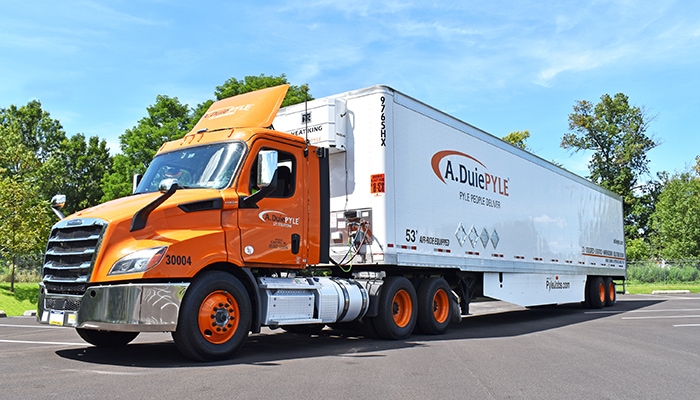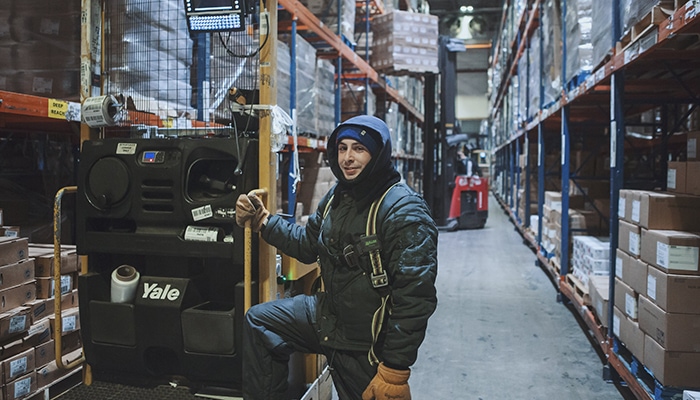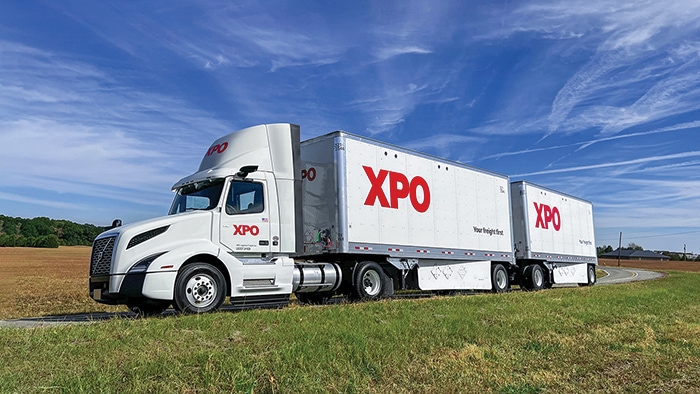14 Ways to Ensure Carrier Service

Gaining the right service levels from your truckers starts before you choose a carrier and then requires effort to maintain. These strategies can help you get the service that rings your bell.
As consumers and businesses continue to boost their expectations for rapid, accurate, and secure deliveries, carriers that can meet these goals offer their shipper clients a competitive edge. “Supply chains are always a competitive weapon utilized by successful businesses,” says Andy Moses, senior vice president of sales and solutions, Penske Logistics.
For instance, shippers can leverage the current increase in carrier capacity and offer more frequent service to their customers. An auto manufacturer might deliver aftermarket parts to dealers five days a week instead of three.
The following guidelines can help you gain the services you need from your carrier partners, so you can, in turn, meet your own customers’ requirements. The first group of tips focuses on steps to take before you partner with a carrier, while the second includes actions that can help you manage existing carrier relationships.
1. Take a partnership approach.
Most shippers are looking for carriers that provide the required capacity at the right times, on the right lanes, at the lowest cost, with the highest on-time delivery.
“Much of this service comes when shippers cultivate carriers as partners, as opposed to being transactional,” says Balaji Guntur, CEO of Hoptek, a Kearney company.
2. Consider a dedicated fleet.
In a dedicated fleet arrangement, a third-party carrier commits to providing the capacity and drivers to handle a shipper’s transportation needs within an agreed-upon region or series of transportation lanes, for a set time.
Arranging a dedicated fleet agreement requires less of an investment than building a private fleet. It also tends to offer higher service levels than more transactional shipper-carrier relationships can, says Nathan Lease, senior director, logistics research and advisory with Gartner.
3. Assess the carrier’s capabilities and experience.
Shippers should understand the service capabilities of the carriers they plan to partner with. They also need to check how well these services match the freight they’re shipping, as not all carriers can handle all their customers’ shipments, says Anthony Hoereth, senior vice president of sales with XPO, a less-than-truckload (LTL) freight provider.
For instance, it’s typically easier to find more carrier options for standard, rather than temperature-controlled or flatbed LTL shipments. As a result, many shippers need either a diverse base of transportation partners, or to partner with a larger LTL provider that can handle a range of freight.
Shippers that are nearshoring also should consider the cross-border capabilities of their carrier partners. This includes their experience, certifications, and the robustness of their networks.
If the carrier will need to meet specific delivery requirements, such as completing deliveries before a retail store opens, ask about their record in this area, recommends Larry Lawrence, chief marketing officer with Pace Runners, which specializes in final-mile logistics.
Once a shipper is working with a carrier, it should be possible to obtain this information from the carrier’s proof-of-delivery reports.
Relevant experience is also important in reducing the likelihood of damaged shipments. For example, a flatbed carrier that mainly supports the steel industry may have little experience securing an appliance in a van trailer.
4. Consider the carrier’s network.
Examine the carrier’s network with the goal of ensuring solid overlap between your lanes and theirs. Another option is to work with a logistics provider that offers “destination commonality,” says Sean Maharaj, chief commercial officer with Hoptek.
5. Evaluate reporting options.
The reports a carrier offers should meet your information needs. For instance, if you need to see proof of delivery on some orders in real time, can the carrier provide that? Does the carrier offer a portal through which you can check the status of your deliveries?
6. Check the carrier’s risk management coverage.
If a carrier lacks appropriate insurance coverage and an accident leads to lost freight, the shipper probably would need to seek reimbursement from the carrier, rather than from an insurer.
However, not all carriers would be able to cover the loss, Lawrence says. Litigation could be an option, but it would consume time and money, and might not provide relief.
7. Evaluate the technology platform.
Ask the carrier about its technology roadmap. A carrier’s ability to provide timely shipment information has become as critical as its ability to move freight shipments.
Among other benefits, technology can help with dock, line haul, and pickup and delivery planning, which reduces shipping costs and handling. “That is a win-win for both parties,” says John Luciani, chief operating officer of LTL solutions with A. Duie Pyle, a transportation and logistics provider.
Also check the carrier’s route optimization software. A solid platform should identify the most cost-effective and efficient ways to move shipments.

Carriers such as A. Duie Pyle have the ability to provide timely shipment information, which has become as critical as their ability to move freight shipments.
8. Vet the carrier’s backup capabilities.
To ensure reliability, carriers need the resources to respond to unforeseen events, such as equipment breakdowns. “Things go wrong in trucking every day,” Moses says.
Check that the carrier has drivers and locations that can be leveraged for support. These resources can smooth over normal disruptions and help to avoid service interruptions.
9. Be transparent.
Shippers that provide accurate information regarding their transportation requirements, volume expectations, and service conditions—including any limitations on cargo liability and accessorial schedules—tend to gain better service, says Jim Ward, president of the Truckload Carriers Association.
In addition, the more knowledge motor carriers have about the characteristics of a shipper’s freight, the more precise they can be in pricing the business.
10. Manage LTL shipments.
The LTL market has always been capacity constrained, so shippers should look for carriers that have been investing in their networks and adding capacity in their service centers, equipment, and labor.
Also look for LTL providers that offer large, national networks, understand their capacity needs, and are willing and able to allocate additional capacity to existing customers.
The following steps can help shippers maintain more effective relationships with existing carrier partners.
11. Use technology to run competitive RFPs.
Shippers need a robust, automated transportation procurement process to effectively manage their carrier partners. Relying on manual processes makes it less practical to change carriers if one doesn’t meet service requirements.
“You want to reshuffle the deck throughout the year versus relying on manual RFP processes and hoping all carriers are meeting service levels,” Lease says.
In some systems, the shipper can publish questions on an online platform and gather carrier responses, says Michael Zimmerman, partner in Kearney’s strategic operations practice.
The questions should cover—and the shipper should verify—the customers for which the carrier provides the same or similar services.
12. Minimize the need for expedited services.
For many shippers, it’s not realistic to never have to expedite shipments. However, solid planning and technology can minimize the need and expense.
When carriers awarded a lane don’t accept it, the shipper should know as quickly as possible, whether through a dashboard or other reporting mechanism. The sooner they can adjust, the less likely they’ll need to expedite.
Strong supply chain visibility can also reduce the need for expedited shipping. “When the shipper knows what it has and where, or what’s about to arrive and when, moments that might otherwise cause an expedite can be alleviated,” Moses says.
When expediting is required, shippers should implement an escalation policy outlining the conditions, such as the possible loss of a large order, under which expediting is allowed. If the expense exceeds a certain level, a more senior team member should approve it.
It also pays to search for all options that will meet customers’ needs. For example, it might be possible to use in-network expediting, rather than engaging a “hot shot” carrier—one that focuses on time-sensitive loads—which is generally more expensive.
Also check if it’s possible to expedite a portion of the order and still meet the customer’s needs. Generally, the smaller the shipment to be expedited, the lower the cost.

Dot Foods streamlines manufacturers’ LTL supply chains by bringing products into its distribution centers, consolidating them with other manufacturers’ products, and shipping weekly to distributors and retailers.
13. Consider consolidating LTL shipments.
Consolidating shipments to create a multi-stop truckload is generally suitable for larger shipments that can fill most of the trailer’s space, Hoereth says. However, while it may be more cost-effective (not always the case) it also may take longer to deliver when compared to shipping through an LTL network.
Dot Foods, a food industry redistributor, works with manufacturers to streamline their LTL supply chains, says Tim Duggan, the company’s senior director of retail channels.
Dot makes every effort to source products directly from their production facilities and pick up in its fleet of multi-temperature trucks in full truckload quantities. It then brings the products into its network of 15 distribution centers across the United States and Canada, consolidates them with other manufacturers’ products, and ships weekly to foodservice distributors and major drug, grocery and other retailers.
“Through our partnership and consolidation model, we give manufacturers the efficiency, savings, and reach they need to grow,” Duggan says.
14. Assess performance continually.
“Shippers should always engage their carriers as closely as possible, ask for and understand their strengths and weaknesses, see the conditions and regions where they perform well and keep them off the lanes where they perform poorly,” Zimmerman says.
Shippers typically do this through a thorough sourcing process, as well as mini-bids to address more specific needs. The process should be complemented by active supplier relationship management, where the shipper monitors various performance indicators, such as carrier load acceptance and on-time-in-full (OTIF) deliveries.
Becoming a Shipper of Choice
Shippers of choice—or ones that carriers like to work with—tend to gain easier access to transportation capacity at better rates, increasing operational efficiency and reducing costs, says Anthony Hoereth, senior vice president of sales with XPO.
These steps can help shippers achieve this status.
Longer-term contracts. Through strategic engagements, like multi-year contracts rather than annual or biannual bid events, the carrier and shipper can evolve together without the disruptions created by an annual bid process, says Jaime Jones, vice president of van network customer service and fleet planning with Werner, a transportation and logistics solutions provider.
Reliability, efficiency, and reasonable terms. The attributes carriers look for when considering whether to work with a shipper tend to be those that help them effectively manage their own businesses. This includes the ability to promptly load and unload trucks that arrive within the scheduled time frames, as well as reasonable transit times based on government regulations.
“Avoid the use of fines or other penalty charges for late-arriving trucks and work collaboratively to resolve identified inefficiencies,” says Jim Ward, president of the Truckload Carriers Association.
If space is available, shippers should provide a safe area for drivers who cannot legally drive to another location, he adds.
Visibility. A lack of visibility into a shipper’s operations and delivery stops can hamper driver efficiency and utilization.
The biggest unknown is how long or how frustrating a customer stop will turn out to be. Friction in a shipper’s operations cascades to carriers and drivers. Addressing factors that create uncertainty and inefficiency on both sides can alleviate this.

PHOTO COURTESY OF WERNER
Carriers Leverage Artificial Intelligence to Improve Service
Artificial intelligence (AI) has the potential to significantly change logistics and transportation.
“While there’s still a lot to learn, we expect that AI will help with load plan efficiency, routing analysis, and driver preferences and capabilities,” says Jaime Jones, vice president of van network customer service and fleet planning for Werner.
One worthwhile application would be to “feed” an AI algorithm all the variables that affect shipment delays and then use the application to predict and mitigate the impact of shipment delays in real time, says Michael Zimmerman, partner in Kearney’s strategic operations practice. While no single such solution exists now, many in the industry are working toward this.
Carriers today are deploying AI tools to optimize service levels and drive down costs, says Anthony Hoereth, senior vice president of sales with XPO. He notes that XPO has made significant advances with three key pieces of technology.
One involves piece-level tracking (PLT), in which each pallet is given a unique identifier and can be tracked independently. This results in fewer shortages, optimized trailer loading, and more efficient labor planning. (While PLT doesn’t directly use AI, it enables the use of AI in other technology solutions, like directed loading)
XPO is also piloting a directed loading approach that leverages proprietary algorithms to assign freight to specific trailers, so it can be loaded in the most efficient way possible. Directed loading aims to significantly reduce how many times freight is touched, which cuts costs and improves service.
Pickup and delivery (P&D) refers to the process of picking up a shipment and delivering it to its final destination after it has been transported through the company’s network. To increase stops per hour and decrease miles per stop, XPO has enhanced its P&D operations by optimizing inbound and outbound delivery route planning through Edge P&D, its proprietary platform, Hoereth says.

Carriers such as XPO are deploying AI and technology to hold down costs and bring up service levels.
